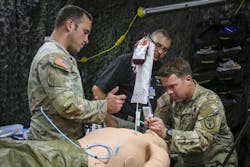Researchers eye robotic and signal processing technologies to control abdominal bleeding on the battlefield
Summary points:
- DARPA plans new MASH program to develop autonomous robotic systems to stop life-threatening torso bleeding on the battlefield.
- Focus is on abdominal hemorrhage control using robotics, sensors, and machine autonomy to extend survival time until evacuation.
- Three-year program will explore hardware and software solutions, including surgical robotics and signal processing for battlefield use.
ARLINGTON, Va. – U.S. military researchers are considering a new project to use robotics, machine autonomy, signal processing, and existing sensors to reduce critical bleeding among those wounded on the battlefield.
Officials of the U.S. Defense Advanced Research Projects Agency (DARPA) in Arlington, Va., issued a future program announcement (DARPA-SN-25-100) last week for the Medics Autonomously Stopping Hemorrhage (MASH) program.
Large-scale combat operations often produce severe warfighter bleeding in the torso -- or the central part of the body that does not involve the head or limbs. The inability to provide rapid damage-control surgery at the scene can cause warfighters to die of survivable injuries.
The MASH program seeks to help battlefield medics who aren't qualified surgeons to stabilize torso bleeding quickly by finding and stopping bleeding autonomously. MASH seeks solutions to stop bleeding for more than hours -- a crucial step to stabilize torso wounds and provide extra time for evacuation to higher levels of care.
Tell me more about non-compressible torso hemorrhage (NCTH) ...
- Non-compressible torso hemorrhage (NCTH) refers to life-threatening bleeding within the chest, abdomen, pelvis, or other area that cannot be controlled by external compression such as tourniquets or pressure dressings. It often occurs deep inside the body, and involves major blood vessels or organs, and is a leading cause of preventable death on the battlefield from hemorrhagic shock that can occur within minutes. Causes are gunshot or stab wounds, blunt force trauma, and military combat wounds. Rapid surgical intervention can make the difference between life and death.
This is not yet a formal solicitation or request for information, and is issued only for information and planning.
MASH will focus on finding and stabilizing the bleed inside the human abdomen via external, laparoscopic, endovascular, or hybrid approaches using machine autonomy, signal processing, existing sensor suites, surgical or endovascular maneuvers, and robotics to find and treat abdominal bleeding on the battlefield.
MASH aims to develop robotic medical devices and procedures to treat battlefield abdominal bleeding that can involve hard-to-find internal damage and sometimes-mangled internal organs.
MASH will be a three-year program with a two-year first phase and a one-year second phase. DARPA strongly encourages teaming to ensure the expertise and capabilities necessary to meet MASH’s goals.
Adapting existing devices
MASH will have two functional areas: the first that involves existing robotic surgical devices and existing end effectors; and the second that involves software and systems development, sensor selection, sensor data, and system autonomy to detect, localize, and stop abdominal bleeding.
The program's first phase will integrate or retrofit effectors into autonomous devices, provide access to a robotic surgical device for the life of the project, and then incorporate phase-two software and sensors.
Companies interested should email [email protected] to join a list for future program updates. More information is online at https://sam.gov/opp/7b87175548d34dedaaaaae4c07d253be/view.
About the Author
John Keller
Editor-in-Chief
John Keller is the Editor-in-Chief, Military & Aerospace Electronics Magazine--provides extensive coverage and analysis of enabling electronics and optoelectronic technologies in military, space and commercial aviation applications. John has been a member of the Military & Aerospace Electronics staff since 1989 and chief editor since 1995.
